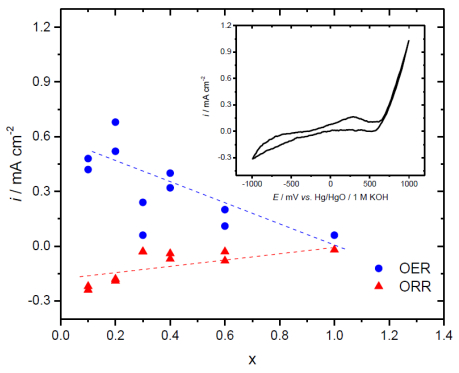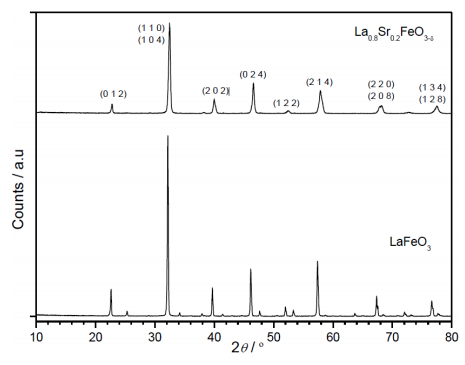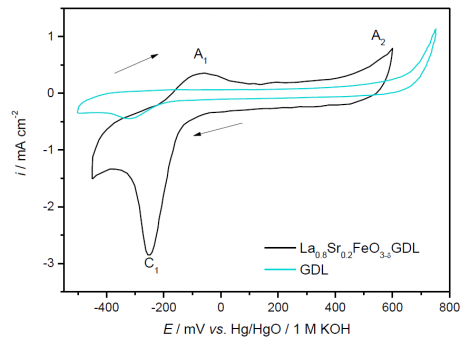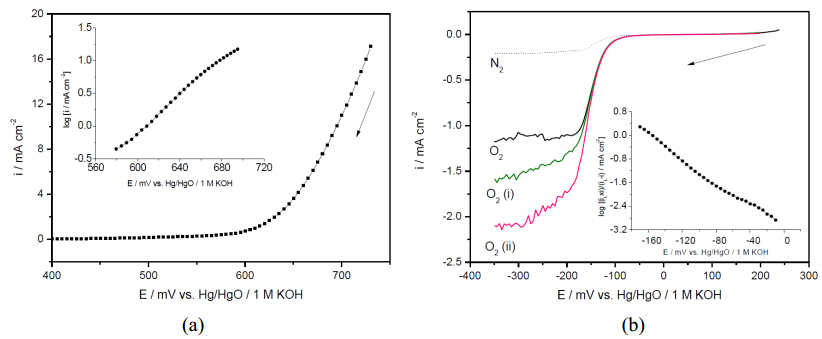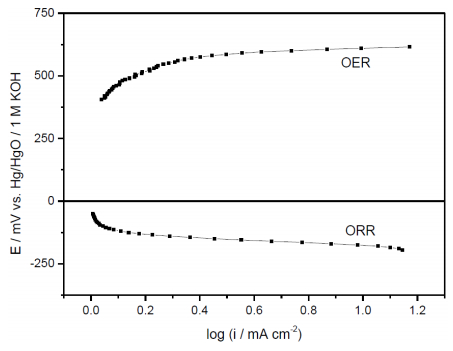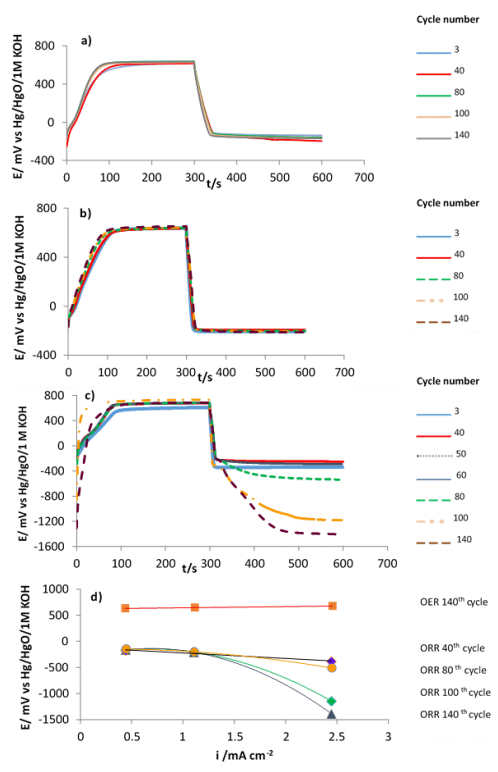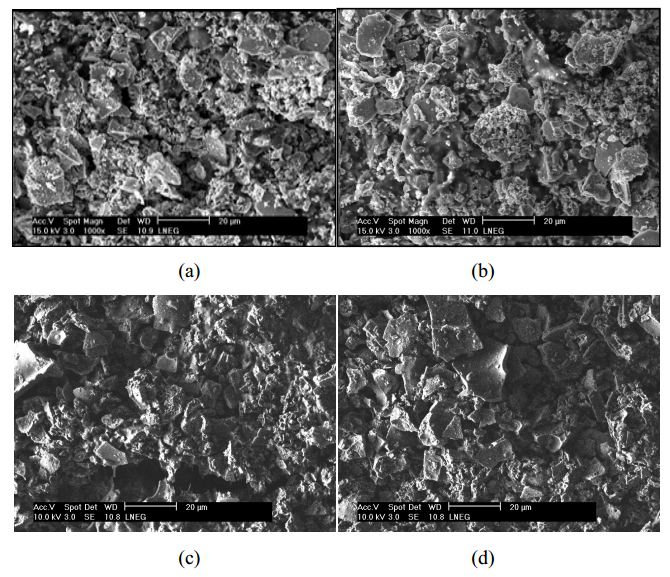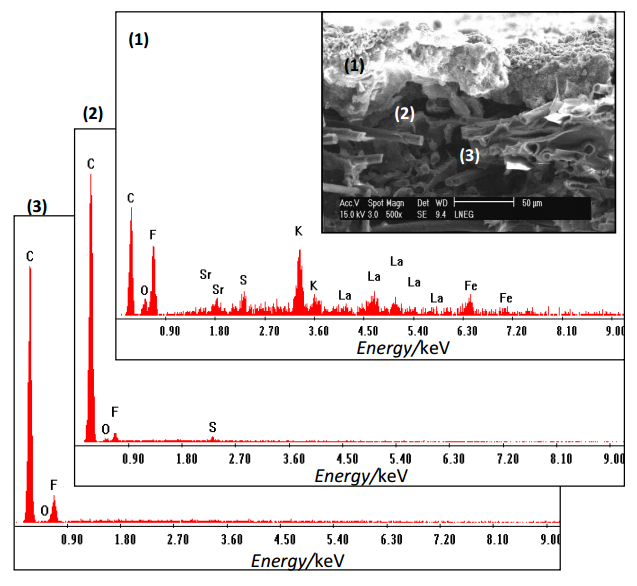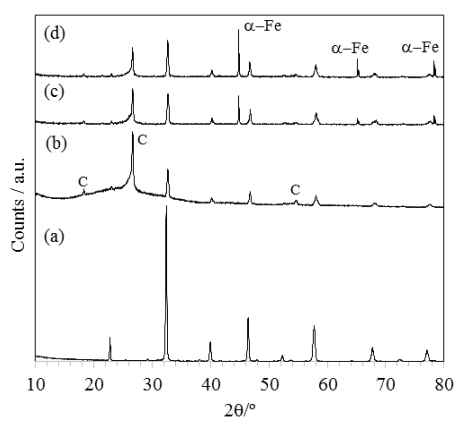Perovskites are important alternatives for precious metals as catalysts for bifunctional oxygen electrodes, involving oxygen evolution (OER) and reduction (ORR) reactions as is the case of regenerative fuel cells. In this work, strontium doped lanthanum ferrite La1−xSrxFeO3−δ (x = 0; 0.1; 0.2; 0.3; 0.4; 0.6 and 1.0) powders were prepared by a self-combustion route. The oxides, in the form of carbon paste electrodes, were characterised by cyclic voltammetry in alkaline solutions. Data analyses lead to the selection of La0.8Sr0.2FeO3−δ to prepare gas diffusion electrodes (GDEs). Cyclic voltammetry and steady state polarization curves were used, respectively, to assess the electrochemical behaviour of GDEs and to obtain kinetic data for both OER and ORR. It is concluded that the oxide preparation conditions/electrode configuration determine the electrode performance. The bifunctionality of the electrodes was assessed, under galvanostatic control, using a cycling protocol within the potential domains for OER and ORR. The potential window, i.e., the total combined overpotential between OER and ORR was found to be of ≈770 mV, value which compares well with that obtained under potentiostatic control. Even though the potential window keeps constant during 140 cycles, the increase in cycling time and/or current density (≥2.5 mA·cm−2) led to a gradual metallization of the GDE surface, as confirmed by Scanning Electron Microscopy and X-ray diffraction analysis.
Abbreviations
iPD: idiopathic Parkinson's Disease; APS: atypical parkinsonisms; MSA: multiple system atrophy; PSP: progressive supranuclear palsy; CBD: corticobasal degeneration; PPS: Parkinson plus syndromes; MRI: magnetic resonance imaging; AI: artificial intelligence; ML: machine learning; ROI: region of interest; PPMI: Parkinson's Progression Markers Initiative; RBD: REM Sleep Behavior Disorder; CSF: cerebrospinal fluid; HCs: healthy controls; SVM: Support Vector Machine; CI: Confidence Interval; DTI: diffusion tensor imaging; QSM: Quantitative Susceptibility Mapping; GRE: gradient-echo; SNc: Substantia Nigra pars compacta; CNN: Convolutional Neural Network; AUC: area under the curve; ROC: receiver operating characteristic (curve); NMS-MRI: neuromelanin sensitive MRI; HD: hypokinetic dysarthria; MCPs: middle cerebellar peduncles; DWI: diffusion weighted imaging; ADC: apparent diffusion coefficient; FA: fractional anisotropy; PCA: principal component analysis; PSP-RS: Richardson syndrome; PSP-P: parkinsonian-type PSP; MDS-UPDRS Ⅲ: Movement Disorders Society Unified Parkinson's Disease Rating Scale part Ⅲ; PIGD: postural instability and gait difficulty; FSSAs: Feature Subset Selector Algorithms; LOLIMOT: Local Linear Model Trees; EEG: Electroencephalography; DFA: discriminant function analysis; ANNs: Artificial Neural Networks; RF: Random Forests; EL: Ensemble Learning; LASSO: least absolute shrinkage and selection operator
1.
Introduction
Idiopathic Parkinson's Disease is the most frequent neurodegenerative movement disorder in the general population, described for the first time as a "shaking palsy" by Doctor James Parkinson in an essay published in 1817. It is mainly caused by a loss of dopaminergic neurons in the substantia nigra causing a reduction in dopaminergic input to the striatum [1]. iPD's clinical hallmark is the onset of cardinal motor symptoms such as bradykinesia, rest tremor, rigidity, and postural instability. Nevertheless, they only occur when at least 60% of the neurons of dopaminergic circuit have suffered irreversible damage [2]. Patient medical history can include other motor (hypomimia, dysarthria, dysphagia, sialorrhea, micrographia, shuffling gait, festination, freezing of gait, dystonia, glabellar reflexes) and non-motor prodromal features (autonomic dysfunction, sleep disorders and sensory abnormalities such as anosmia, paresthesia and pain) and psychological or cognitive deficits (cognitive decline, depression, anxiety) [3]. iPD diagnosis is still based on clinical criteria and a definite diagnosis is obtained only pathologically [4,5]. Thus, diagnostic process is complex and mainly based on the professional knowledge and clinical experience of the physician [6].
When the initial assessment is performed by a movement disorder expert neurologist, the accuracy for clinical diagnosis is about 80% [7]. It is currently impossible to obtain greater diagnostic accuracy using only clinical criteria as iPD shares some clinical and pathological characteristics with other nosological entities, creating the wider spectrum of "parkinsonian syndromes". The greatest challenge is to distinguish iPD from other similar neurodegenerative disorders, "atypical parkinsonisms", such as multiple system atrophy, progressive supranuclear palsy and cortical basal degeneration, as well as other neurodegenerative disorders [8]. As atypical parkinsonism, also called "Parkinson plus syndromes", often have a rapid progression and worse prognosis and even iPD in and of itself presents variants with different prognosis, it is necessary to identify biomarkers allowing to distinguish between these entities [9]. Research efforts are aimed at obtaining an exact and early diagnosis to promptly set up an appropriate therapy and inform the patient about the expected disease evolution [10,11,12].
The use of Neuroimaging for research purposes is justified by the search within the image data of biomarkers, in the form of structural [13,14,15,16] and/or functional [10] variations, especially under the form of quantitative measurements [17,18,19,20], allowing an early identification of Parkinsonian patients and an accurate distinction between them and other neurodegenerative motor disorders [21,22,23,24].
In this context, brain magnetic resonance imaging is routinely performed in the parkinsonian diagnostic work-up, yet its role is essentially limited to rule out concomitant brain disorders rather than for diagnostic purposes. However, MRI can demonstrate morphological changes supporting the diagnosis of full-blown PD and atypical parkinsonian syndromes [25]. Moreover, it is current opinion that MRI data of parkinsonian patients contain information about microstructural changes [26] and, although they are not visible to the human eye, they could be identified with the use of recent artificial intelligence technologies, in particularly using machine learning algorithms. ML consists of algorithms capable of generalizing rules or patterns from a labeled set of input data and, using that knowledge, to generate predictions or classifications on data not seen before [27,28,29]. The advantage of applying ML algorithms to the biomedical field lies in the ability to process very large datasets, often containing numerous and different variables with possibly noisy and redundant information, challenging to analyze using a traditional statistical approach [30,31].
Parkinson's disease is extremely complex and there are many aspects that are not completely clear therefore the research is carried out on several fronts, such as genetic, pathological, molecular, clinical and radiological and in each of these fields features can be found to be included in the ML algorithms to improve diagnosis and implement our knowledge [32,33].
In recent years numerous studies, which will be discuss further in detail, have published with the purpose of applying an ML-based approach to elaborate morphological and advanced neuroimaging data with the aim of identifying biomarkers able to distinguish between parkinsonian patients and healthy subjects [34,35,36], to help clinicians understand the underlined neurodegenerative pathological mechanisms [37,38,39,40,41], to differentiate the various subtypes of APS from each other [42,43,44,45,46,47] and to predict prognosis [48,49,50], clinical evolution [51,52] and response to therapies [53,54].
Our aim was to review the recent literature and describe the current knowledge about the contribution given by ML applications to research and clinical management of parkinsonian syndromes.
Using Pubmed database we entered in the search engine keywords such as "parkinson disease", "parkinsonism", "machine learning", "imaging", "magnetic resonance" and included all articles published up to August 2020 in English language that contained these words in the title and/or abstract.
This first search highlighted 58 articles and, after reading the abstracts, 22 articles were considered compatible with the purpose of our review. The main reasons for exclusion were the application of AI to other data, such as genetic or clinical ones, and/or only a marginal use of neuroimaging.
2.
Machine learning and Neuroimaging data
In recent years, the number of publications concerning the application of AI in the neuroradiological field have increased exponentially [55,56]. The power of ML, a particular application of AI, lies in the ability to employ and analyze an enormous amount of data, much more efficiently than with classical statistical analyzes. Moreover, ML algorithms can learn and improve from experience over time [27,28]. Diagnostic images contain numerous information relevant for the diagnosis, for understanding the pathological mechanisms and predicting the clinical evolution of patients. Much of this information is currently underutilized but still contained in the imaging exams. As ML systems can extract wide features datasets within which identify markers and correctly classify patients without the need to make a priori selection of characteristics or regions of interest, the interest in ML algorithms in diagnostic imaging is rapidly increasing.
Among the clinical-neuroradiological applications, those concerning neuro-oncology certainly represent the greatest number. In particular, several studies have been published on the detection and identification of prognostic and predictive markers in adult patients with gliomas [57], in pediatric brain neoplasms [58] and in patients with brain metastases [59]. A further field of interest is that of multiple sclerosis, in which efforts have been made to automate lesion load calculation and predict long-term disability in patients affected by this disease [60]. Finally, machine learning applied to imaging has shown promise in the identification of biomarkers of neurodegeneration [61] or psychiatric conditions [62], as well as in the study of cerebrovascular pathology [63].
3.
Role of ML for early diagnosis
iPD and PPS diagnosis are based on clinical criteria but motor symptoms, whose presence is necessary for the diagnosis, become evident only at an advanced disease stage leading to late, and not always correct, diagnosis.
In recent years, clinical research has focused on the identification of prodromal symptoms, which may be used as a biomarker for the identification of subjects who will develop movement neurodegenerative disorders, to predict those who will benefit from an early treatment plan to slow down the neurodegenerative process [64,65].
Recent evidence, in fact, suggests that treatment of iPD could be more effective if started in the prodromal phase [66]. For this reason, several studies have been organized and it is currently known that pre-motor symptoms such as hyposmia, constipation, REM sleep behavior disorder and depression may antecede iPD motor symptoms for years [67]. However, none of these symptoms are sufficiently specific and sensitive to be used as a screening tool. Therefore, it is essential to continue in the search for potential biomarkers, such as genetical, biochemical or neuroimaging features, which alone or in combination can increase the possibility of identifying subjects at risk of developing parkinsonism. Since ML approach is known to be able to process a considerable amount of data in order to recognize the most important features for classifying patients, it is easy to understand that its application in the field of early diagnosis and in the identification of microstructural alterations resulting from the neurodegenerative process is topical. While sensitivity of clinicians in looking for prodromal symptoms has significantly increased, there is a need to correlate these early symptoms to the underlining morpho-structural changes in order to use quantitative or standardized measure to precisely stratify the risk of subjects to phenoconvert to iPD.
A large dataset of information, including genetic, biochemical, clinical and neuroimaging data, regarding ex novo iPD patients (i.e. subjects with a diagnosis of PD for two years or less who are not taking PD medications) and "prodromal subjects" (i.e. subjects without Parkinson's disease who have a diagnosis of hyposmia or REM sleep behavior disorder), has been collected by PPMI and is currently available for researchers in order to identify biomarkers to help clinicians predict progression of neurodegenerative process [68]. Using PPMI dataset, Prashanth et al. [34] tried to find the best ML approach to identify early PD patients through the use of multimodal features such as non-motor features of RBD and olfactory loss, along with CSF measurements and dopaminergic imaging markers. They enrolled 183 HCs and 401 PD patients and tested several ML approaches such as Naïve Bayes, SVM, Boosted Trees and Random Forests classifiers. They observed that SVM classifier gave the best performance (96.40% of accuracy, 97.03% of sensitivity, 95.01% of specificity, and AUC of 98.88%).
Also,
Óscar Peña-Nogales et al. [35] have suggested that is possible to quantify neurodegenerative patterns of progression in the prodromal phase using longitudinal diffusion MRI connectivity data. Authors identified a ML algorithm that is capable, through a longitudinal brain connectome progression score, to discriminate between the progression of PD and control groups with an AUC of 0.89 [95%; (CI): 0.81-0.96] and discriminate the progression of the high risk prodromal and control groups with an AUC of 0.76 [CI: 0.66-0.92].
To provide an early diagnosis is essential to identify the most appropriate imaging modality, capable to detect the most specific alterations. As diagnostic performance of various imaging modalities may vary across subjects with different phenotype stages, Liu et al. [36] have tried to apply ML algorithms to understand which imaging strategy was most appropriate for each patient. They aimed to obtain a "tailored imaging strategy" and reported interesting results regarding the role of fractional anisotropy of DTI studies.
Although the role that brain iron accumulation plays in the neurodegenerative process is still not clear, many studies have demonstrated an abnormal and early increase of iron deposits in nigrostriatal dopaminergic system. Based on this assumption, Xiao et al. [20] used QSM, an imaging technique that can quantify the magnetic susceptibility value of brain tissue from GRE MRI data providing an excellent contrast between iron-rich areas and surrounding tissues to analyze SNc involvement using both a radiomic and a CNN based approach to support the diagnosis of PD. They found that the extraction of radiomics features and the CNN features were complementary to each other to improve the classification performance (obtaining an AUC of 0.96).
This research field is important for early recognition of patients who may benefit from any neuroprotective treatment and delay the onset of disabilities related to associated motor and neurocognitive disorders.
4.
The use of ML to identify unknown pathological changes
As previously stated, the ability of ML models to identify biomarkers determines numerous advantages. First, using a reverse process it is possible to identify the most significant changes present only in affected subjects [27,28]. Consequently, trying to assess the role that these changes play in the onset of symptoms or in their clinical evolution is extremely helpful to understand the spread of the neurodegenerative process. Still to this day, our knowledge about the different brain areas involved in the onset and progression of symptoms is limited. Indeed, it is current opinion that morphological and advanced neuroimaging exams contain information not visible to the human eye regarding microstructural changes. This textural information is potentially probably capable of distinguishing patients and HCs, to classify different clinical phenotypes and hopefully to predict clinical evolution or therapy response [26].
In recent years, several magnetic resonance techniques have been developed to study the integrity of the mesencephalic substantia nigra since its initial damage is considered the pathological hallmark of iPD [69]. For this reason, Sumeet Shinde et al. [37] examined NMS-MRI of 41 PD, 20 PPS and 35 HCs. Authors employed a boxed region around the brainstem on the axial slices of a Neuromelanine Sensitive-MRI 3D-T1w sequence as input to a 2D Convolutional Neural Network used to classify PD and HCs and found a cross-validation accuracy of 83.7% (AUC-ROC = 0.90) and test accuracy of 80% (AUC-ROC = 0.91). A separate CNN based classifier was constructed to discern PD from PPS (MSA and PSP) performing with a cross- validation accuracy of 81.8% and a test accuracy of 85.7%. The constructed algorithm has the capability to locate the most discriminative regions on the neuromelanin contrast images. These discriminative activations demonstrate that the left SNc, plays a key role in the classification in comparison to the right one. These findings agree with the frequent onset of asymmetrical motor symptoms in the initial stage of iPD, Peng et al. [38] used a multilevel-ROI-features-based ML method to detect sensitive morphometric biomarkers in PD and found better results compared with other classification methods using single-level features. This study integrated several low-level ROI features (gray matter volume, cortical thickness, etc.) and high-level correlative features (connectivity between ROIs) in a single method and applied it to T1-weighted brain MRI of 69 PD patients and 103 HCs. This ML method has high performance in classification between PD patients vs normal controls with an accuracy of 85.78%, a specificity of 87.79%, and a sensitivity of 87.64%. The Authors have also concluded that the most sensitive biomarkers are mainly ROI-based features in the frontal lobe, parental lobe, limbic lobe, temporal lobe, and central region.
Using morphological data of iPD patients such as cortical thickness, subcortical structure, and white matter volume, Chen et al. [39] analyzed the possible association of their pathological alterations with the onset of hypokinetic dysarthria (HD), a typical parkinsonian motor symptom affecting the speech, evidenced by reduced vocal loudness, monotone, reduced fundamental frequency range, consonant and vowel imprecision, breathiness, and irregular pauses. The presence of these speech deficits negatively impacts intelligibility, functional communication and, ultimately, social participation. Chen et al. found a significant association between the presence of this symptom and the atrophy of the right precentral cortex and the right fusiform gyrus. After feature selection, a machine-learning model was established using a support vector machine in the training set to predict HD severity obtaining optimal performance with a correlation coefficient (r) of 0.7516 and a coefficient of determination (R2) of 0.5649 (P value < 0.001).
Since still there are not objective quantitative indicators to base parkinsonism diagnoses only on imaging data, a multi-features approach seems to be more effecting in discriminating patients from healthy subjects. Glaab et al. [40] demonstrated that integrating blood metabolomics data combined with PET data considerably enhances the diagnostic discrimination power between patients with PD and HCs. In fact, they have recruited 60 PD patients and 16 HCs, collected blood plasma samples and performed FDOPA PET and FDG PET. Data sets were then analyzed with two ML approaches (linear SVM or Random Forests within a leave-one-out cross-validation scheme). AUC was highest when combining standardized imaging features with those from the metabolomics data (SVM AUC for FDOPA + metabolomics: 0.98; SVM AUC for FDG + metabolomics: 0.91). By contrast, the performance was lower when using only the respective PET attributes (AUC for FDOPA: 0.94, AUC for FDG: 0.8) or only the metabolomics data (AUC: 0.66). A Random Forest approach for model building provided better or similar prediction results in all cases. This study suggests that the integration of different types of data allows to increase the diagnostic power of classifiers.
5.
Parkinsonian Syndromes and the role of ML in the differential diagnosis
When PD is combined with other clinical signs, it is called "Parkinson plus, " an overarching term that includes MSA, PSP and CBD [70]. We will briefly summarize the characteristics, not only of imaging, of those main parkinsonian syndromes and then discuss about the role of ML in differential diagnosis.
5.1. Multiple System Atrophy
MSA is an adult-onset sporadic neurodegenerative disorder that includes three disorders that were previously regarded as separate entities: striatonigral degeneration, olivopontocerebellar atrophy, and Shy-Drager syndrome. These disorders are all now recognized as clinical MSA subtypes and are identified by dominant symptomatology. When parkinsonian (i.e., extrapyramidal) symptoms predominate, the disease is designated MSA-P. If cerebellar symptoms such as ataxia predominate, the disorder is defined MSA-C. When signs of autonomic failure such as orthostatic hypotension, global anhidrosis, or urogenital dysfunction predominate, the condition is called MSA-A. Although there can be some overlap, the imaging findings for the two most common MSA subtypes are somewhat different. In patients with MSA-P, the putamina appear small and hypointense on T2WI and often have a somewhat irregular high signal intensity rim along their lateral borders on 1.5-T scans ("hyperintense putaminal rim" sign). T2* show significantly higher iron deposition in the putamen. DTI shows decreased FA in the pons and middle cerebellar peduncles. In patients with MSA-C, T1 scans show a shrunken pons and medulla, symmetric cerebellar atrophy, small concave-appearing MCPs and an enlarged fourth ventricle. T2/FLAIR scans demonstrate a cruciform hyperintensity in the pons termed the "hot cross bun sign" that results from selective loss of myelinated transverse pontocerebellar fibers and neurons in the pontine raphe. DWI shows elevated ADC in the pons, MCPs, cerebellar white matter, and dentate nuclei. DTI demonstrates decreased volume of fiber bundles and reduced FA in the degenerated transverse pontocerebellar fibers and in corticospinal tracts [70].
5.2. Progressive Supranuclear Palsy
PSP — also known as Steele-Richardson-Olszewski syndrome — is a neurodegenerative disease with a variable disease course and characterized by supranuclear gaze palsy, postural instability, and mild dementia. It is the most common of the Parkinson-plus syndromes with an insidious symptom onset, typically beginning in the sixth or seventh decade. Two PSP phenotypes are recognized: Richardson syndrome and parkinsonian-type PSP. PSP-RS is the classic, more common presentation with lurching gait, axial dystonia, and early ocular symptoms. Vertical supranuclear gaze palsy is the definitive diagnostic feature but typically develops years after disease onset. One-third of patients exhibit the PSP-P phenotype. Parkinsonism dominates the early clinical picture with bradykinesia, rigidity, normal eye movements, and transient response to levodopa. Sagittal T1- and T2-weighted images show midbrain atrophy with a concave upper surface (the "penguin" or "hummingbird" sign). Volumetric calculations show that the sagittal midbrain is less than 70 mm³ and that the midbrain/pons ratio is less than 0.15. Axial scans show a widened interpeduncular angle and abnormal concavity of the midbrain tegmentum [71]. In addition to a small midbrain, enlarged third ventricle, and prominent perimesencephalic cisterns, the quadrigeminal plate is often thinned. Cerebellar atrophy is common, and the superior cerebellar peduncles also frequently appear atrophic. DTI indices demonstrate widespread white matter abnormalities that are often mild or inapparent on T2/FLAIR. FDG PET shows glucose hypometabolism in the midbrain and along medial frontal regions [70].
5.3. Corticobasal Degeneration
CBD is an uncommon sporadic neurodegenerative and dementing disorder that has multiple clinical phenotypes and different associated syndromes. It typically affects patients 50-70 years of age. CBD's onset is both insidious and progressive. This disease can be associated with a broad variety of motor, sensory, behavioral, and cognitive disturbances. Levodopa-resistant, asymmetric, akinetic-rigid parkinsonism and limb dystonia (usually affecting an arm) are classic findings. Rigidity is followed by bradykinesia, gait disorder, and tremor. "Alien limb phenomenon" occurs in 50% of cases. Conventional imaging studies show moderate but asymmetric frontoparietal atrophy, contralateral to the side that is more severely affected clinically. The dorsal prefrontal and perirolandic cortex, striatum and midbrain tegmentum are the most severely involved regions. FLAIR scans may show patchy or confluent hyperintensity in the rolandic subcortical white matter. SPECT and PET demonstrate asymmetric frontoparietal and basal ganglia/thalamic hypometabolism [70].
5.4. ML in the differential diagnosis
The most urgent and difficult clinical problem is not the classification of PD patients from healthy controls, but the discrimination of idiopathic PD versus those other atypical parkinsonisms. MRI studies show that there are different brain imaging changes in these diseases. Researchers have tried different MR features to train a classification model. Structural MRI was the most used modality [72].
For example, Salvatore et al. [42] have tried to identify patients with PD based on T1w MRI with accuracy, specificity, and sensitivity > 90%. In fact they took a ML algorithm based on combination of PCA and SVM with 28 PD patients, 28 HC subjects and 28 PSP patients and they found that voxels influencing classification between PD and PSP patients involved midbrain, pons, corpus callosum and thalamus. Correia et al. [43] have tried to compare different approaches to minimize bias in the feature selection for the classification of PD vs CBD and PSP using ML. They recruited a cohort of 69 HCs and 35 patients with iPD, 52 with PSP and 36 with CBD. Using standardized T1-w and DWI MRI, they suggested that using PCA for feature extraction provided higher classification accuracies when compared to a ROI-based approach. Also, Archer et al. [44] with an international study of 17 MRI tried to provide an objective, validated, and generalizable imaging approach to distinguish different forms of parkinsonian syndromes using multisite DWI MRI. They used images of 1002 patients and the Movement Disorders Society Unified Parkinson's Disease Rating Scale part Ⅲ to develop and validate disease-specific ML comparisons using 60 template regions and tracts of interest in Montreal Neurological Institute space between PD and atypical parkinsonism (MSA and PSP) and between MSA and PSP. Results demonstrated that the DWI MRI plus MDS-UPDRS Ⅲ model (PD vs atypical parkinsonism: AUC of 0,962; MSA vs PSP: AUC of 0,897) and DWI MRI only model had high AUCs (PD vs atypical parkinsonism: AUC of 0,955; MSA vs PSP: AUC of 0,926), whereas the MDS-UPDRS Ⅲ only models had significantly lower AUCs (PD vs atypical parkinsonism: AUC of 0,775; MSA vs PSP: AUC of 0,582). Instead, Du et al. [45] used the ability of DTI and the apparent transverse relaxation rate (R2*) from the striatal, midbrain, limbic, and cerebellar regions of 106 subjects, and their combination for differentiating PD, MSA, PSP and HCs. The application of Elastic-Net revealed that DTI and R2* together were significantly better than DTI or R2* alone in separating controls from those with PD/MSA/PSP (AUC: 0.88; P value < 0.013); controls from those with PD (AUC: 0.91, P value < 0.001); those with PD from those with MSA/PSP (AUC: 0.94, P value < 0.038); and those with PD from those with MSA (AUC: 0.99; P value < 0.006). Finally, using a complex neural approach and T1w-MPRAGE sequences, Amoroso et al. [46] aimed to study differences in brain connectivity in PD and HCs by dividing the brain volume of each subject in patches of 125 voxel and measured how different brain regions are correlated. They build a model including atrophy effects locally induced by the disease and accounting for whole-brain modifications thanks to the network framework.
6.
ML to establish the prognosis
It is known that there are different iPD clinical phenotypes [73]. iPD patients can be divided into three subtypes according to their clinical symptoms: tremor dominant, bradykinesia/akineto-rigid, and postural instability and gait difficulty. Different phenotypical subtypes have varying responses to treatment and different prognoses. In particular, PIGD variant has a relative malignant course, including shorter life expectancy, faster progression, worse prognosis, and higher risk of complications [74]. Gu et al. [47] aimed to create a classifier using resting-state functional, 3D T1-weighted and DTI data to distinguish PIGD from others. Their classifier discriminated patients with the PIGD subtype with a diagnostic accuracy, sensitivity, and specificity of 92.31%, 84.21% and 96.97%, respectively.
The necessity of classify patient according to the severity of clinical phenotype is even more urgent in PPS because they are known to have a more rapid and malignant course. Chen Y L et al. [51] tried to develop a ML algorithm based on DTI to predict the clinical severity of PSP and found that it confidently predicts the clinical severity of PSP at the individual level (adjusted R2: 0.739 and 0.892, p < 0.001) and that the most involved regions for each severity clinical score analyzed (UPDRS motor section; PIGD staging; MHY, modified Hoehn and Yahr staging; LEDD, levodopa equivalent daily dose in unit of mg/day) mostly involved cortical motor areas and basal ganglia, fundamental areas for the correct planning and execution of voluntary movements. Moreover, it is difficult to classify the severity of the clinical picture on the sole basis of the medical examination as iPD patients present daily fluctuations in their clinical conditions in relation to the intake of medicines and its amount of absorption. In this context, independent and quantitative imaging biomarkers are desirable to improve the diagnostic accuracy and to quantify the clinical severity status.
As thalamus plays an important role in iPD pathogenesis and onset of symptoms, Chen et al. [52] evaluated morphological changes in thalamic subnuclei using structural MRI data. They evaluated the volumes of 25 thalamic subnuclei using FreeSurfer and a newly developed thalamus segment algorithm. The individual PD diagnosis and clinical condition prediction were conducted on SVM classification or regression. Results demonstrated that with this ML approach an accuracy of 95% with sensitivity of 97.44%, and specificity of 90.48% can be achieved in PD diagnosis and that clinical severity and improvement prediction can be achieved based on morphology of thalamic subnuclei via ML.
Using fMRI data of iPD on- and off-therapy and HCs performing task related to working memory, Poston et al. [41] elaborated an algorithm able to differentiate between PD off-therapy and HC participants with a 78.26% cross-validation accuracy. They used a linear SVM algorithm applied to a binary mask containing 8 spherical regions from cortical and subcortical areas that showed load-dependent brain activation defined by the peak voxels detected in fMRI group analysis, they also demonstrated that intact working memory in cognitively unimpaired PD is associated with increased activation within the bilateral putamen and bilateral posterior insula. Critically, dopaminergic medications reduced putamen hyperactivation, and individual differences in loss of compensatory hyperactivation were associated with slower cognitive speed.
ML algorithms have also been applied to nuclear medicine data for the study of stratification of parkinsonism severity status and prognosis prediction. Using clinical and nuclear medicine imaging features as predictors, Salmanpour et al. [48] demonstrated an excellent prediction of motor outcome in PD patients by employing automated hyperparameter tuning and optimal utilization of FSSAs for more systematic initial feature selection and predictor algorithms, such as the LOLIMOT predictor machine that resulted in the lowest absolute error (4.15 ± 0. 46). Furthermore, the intake of drugs could lead to changes in the neuronal connectivity of the dopaminergic circuits so patients should be studied before starting therapy.
Waninger et al. [49] demonstrated that changes in cortico-cortical and cortico-thalamic coupling were observed as excessive EEG beta coherence in iPD patients, and correlated with UPDRS scores and dopamine transporter activity, supporting the potential for cortical EEG coherence to serve as a reliable measure of disease severity. Using ML approaches, an EEG DFA classifier was identified that parallels the loss of dopamine synapses as measured by dopamine transporter PET. The overall accuracy of the DFA classifier in discriminating the iPD and control groups in this study was compelling since only two of the 42 total subjects included in the analysis were misclassified, resulting in 95.24% specificity and 94.74% sensitivity.
The aim of the study of Tang et al. [50] was to predict the UPDRS Ⅲ motor score at year 4 using 92 imaging features extracted on 12 different brain regions from DaTscan SPECT data as well as 6 non-imaging demographic and clinical measures at baseline (year 0) of 69 PD patients using SVM and Artificial Neuronal Networks. Results demonstrated that among non-imaging features only UPDRS Ⅲ at year 0 reached a predictive accuracy of 70% if used individually but combining the top imaging features from the selected regions significantly improved the prediction accuracy to 75% (P value < 0.01).
Prediction of clinical outcome and the efficacy of the therapies is another essential point in the management of the patient with parkinsonism. Chih-Chien Tsai et al. [53] used diffusion images data and a stepwise multivariate regression model to predict clinical evolution of iPD patients over a 2-year follow-up. The predicted UPDRS for everyone was consistent with the observed values at blind validation (adjusted R2: 0.76) by using 13 features, such as mean diffusivity in lingual, nodule lobule of cerebellum vermis and fractional anisotropy in Rolandic operculum, and quadrangular lobule of cerebellum. Peralta et al. [54] tried to stratify patient clinical severity status using striatal shape alteration and a fully automated, cross-validated pipeline. The ML and data analysis quantified the relevance of shape displacements of putamen and caudate nucleus as diagnostic and staging biomarkers, benchmarking different classifiers and structures. All these studies suggest the need of identify quantitative and objective biomarkers to evaluate the progression and therapy response of motor disorders, since daily motor and cognitive status fluctuations of the patient, dictated by the intake and absorption of drugs, could make the clinical evaluation untrue.
7.
Results and limitations of the analyzed studies
We reported in Table 1 the results achieved by the main studies included in our discussion.
All the papers analyzed in this review were published in the last 5 years. This data can be explained by the fact that AI is a relatively recent and innovative field and its applications to the medical and non-medical fields is in continuous and rapid expansion.
The most common ML algorithm used was SVM, one single study used deep learning, and no one used unsupervised learning. Despite the type of algorithm used, most of the algorithms reached an accuracy above > 70%.
However, some considerations about these results are needed and it is necessary to underline some limitations.
Most studies were based on small size samples, especially the ones which aim was to provide biomarkers for a differential diagnosis. This can be explained by the fact that, despite the wide prevalence of iPD, the PPS are relatively rare.
Moreover, given the reduced size of samples, most studies used a subset of data to train the ML algorithms while the ones with a large dataset mostly used the PPMI data. These conditions could lead to the possibility of "over-fitting", this means that the ML algorithms have a high classification accuracy in the training set and reduced reliability in classifying when new data are provided.
In addition, PD and PPS are a wide spectrum of neurodegenerative motor disorders with different clinical subtypes, and probably essential different underlying pathological changes. Most of the studies neglected the complexity of parkinsonian syndromes and often did not considered the presence of subtypes.
Lastly, most studies used as input data from a single modality of imaging technique since is difficult for ML algorithms manage simultaneously a huge number of variables. Nevertheless, it will probably be more helpful to use multimodality neuroimaging data or combine radiological with genetic, biological and clinical information.
Consequently, for future studies we recommend using large samples, taking into account the various clinical phenotypes of diseases which often have different prognoses and trying to integrate different types of information in order to identify the most significant markers, for the classification and evaluation of parkinsonian disease, especially in the prodromal phase.
Conclusions
Artificial intelligence applied to neuroimaging studies is providing a significant contribution to shed light on the pathogenetic mechanisms underlying the onset of symptoms of parkinsonian syndromes. The application of ML algorithms to radiological data is also giving useful results to manage diagnosis, predict clinical evolution and distinguish PD from the other parkinsonism and neurodegenerative disorders.
Conflict of interest
All authors declare no conflicts of interest in this paper.









 DownLoad:
DownLoad:


